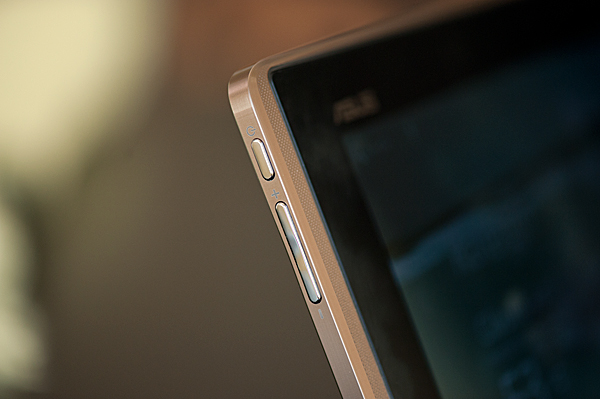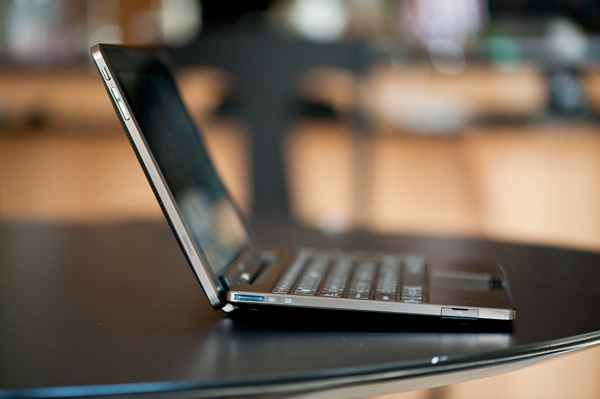ASUS Eee Pad Transformer Review
by Anand Lal Shimpi on April 21, 2011 4:00 AM ESTFinal Words
ASUS delivered three things with the Eee Pad: a very competitive price point ($399), a surprisingly useful (albeit pricey) dock, and a good display. The price point alone is enough to make the Eee Pad the Honeycomb tablet to get assuming you don't need integrated 3G or LTE connectivity. The Eee Pad is comfortable to hold and use and despite the lower price point you don't feel like ASUS has sacrificed much at all to make it. The display has similar characteristics to what Apple ships in the iPad 2. Overall from a hardware standpoint, the Eee Pad is solid.
The Transformer dock is an extremely tempting addition to the Eee Pad, I only wish it were cheaper. When in use the dock extends battery life by 64%, pushing the Eee Pad past 15.5 hours in our general WiFi test. ASUS tells me that the Transformer dock will be compatible with all Transformer branded tablets in the future. I can imagine a thinner Kal-El based version must be in the works at this point.
Tight integration between the keyboard/trackpad and Honeycomb makes the Eee Pad Transformer one part tablet and one part Android netbook, and the whole thing works a lot better than I expected it to. When you need a netbook form factor, you have one, and when you just want to kick back and relax with a tablet you've got that as well. The experience isn't quite fast enough for me to replace my notebook, but I can see where things are headed.
I actually believe the dockable tablet is indicative of where the netbook (and perhaps ultra portable notebook) market is going. Give me some more (or faster) cores and an OS even better suited for notebook duty and the line between a tablet and a netbook becomes quite blurry. I finally understand why NVIDIA opted for four cores in Kal-El and why Microsoft keeps looking to Windows 8 to be its tablet strategy. Windows 8 tablets will be Windows 8 netbooks; they'll just be modular.
The biggest issues here are software related. Honeycomb has matured significantly just with the 3.0.1 update, but there are still dock and camera behavior issues that need to be worked out before ASUS takes the Eee Pad to market. I feel like Honeycomb got a worse rap than it deserves, but there are real issues that need addressing here. I lost a couple of pages of this review thanks to an unexpected hard lock and a reboot while typing this on the Eee Pad. For casual use it's not an issue but the platform isn't mature enough for real work yet.
So why do companies keep introducing tablets with known software issues? I always remember what AMD's Eric Demers once told me: the best way to lose a fight is to not show up.












127 Comments
View All Comments
stm1185 - Thursday, April 21, 2011 - link
Great review. I don't see much current use for the transformer now, but the idea of having something as capable as my old 2.6ghz quad core Phenom tower, in a tablet/netbook, running Windows 8, that is just awesome. I can't wait to see what Asus, MS, and Nvidia or Intel come up with next year.damianrobertjones - Thursday, April 21, 2011 - link
Asus EP121Acer 1820ptz
Dell latitude XT2
HP Elitebook 2740p
and many more... they are available NOW!
anishannayya - Thursday, April 21, 2011 - link
I own the x201T, and while it is a great device, it isn't meant for everyone (it is a convertible tablet PC). While it runs Windows 7, has multi-touch capable screen (and has multiple levels of pressure sensitivity with a stylus), gets 7 hours of battery life, and works like a conventional PC in other ways; it is also nearly 4 pounds with the extended battery and has a typically "large" 12.1" laptop form factor.The EEE Pad is designed for people who want a thin, lightweight device that is relatively mobile and offers ultra-long battery life. If you don't need to use Windows style applications (90% of consumers), then this device is more suitable than even a traditional PC.
spambonk - Thursday, April 21, 2011 - link
And all of them crap.TylerTech - Sunday, April 24, 2011 - link
I also own an x201 (work purchased it for a project) I always have a hard time finding a good use for it. If I was using the stylus to draw it would be perfect but I don't.I would rather have the transformer or xoom and use them as a reading device. I just hope they improve browser sync to the point where its seamless as mentioned in the review.
medi01 - Thursday, April 21, 2011 - link
Turning notebook into a tablet and vice versa is a brilliant idea. I bet most manufacturers will follow.Spivonious - Thursday, April 21, 2011 - link
You do realize that convertible laptops have been around for 10 years, right?therealnickdanger - Thursday, April 21, 2011 - link
Yeah, I owned a couple. Bulky, expensive, hot, poor battery life. Obviously they can do more work, but you pay for it in many ways. I've always been a tablet fan, but they have never been as simple and easy as Android/iPad.I'm still looking forward to sub-$200 pads. And if Microsoft can make Windows8 bridge the gap between regular PC work and content creation with the mobile content consumption models, then the world will be a perfect place.
Too bad the world is ending in 2012, so we'll only have a short time to play with it.
spambonk - Thursday, April 21, 2011 - link
You do realize they were rubbish?VooDooAddict - Sunday, April 24, 2011 - link
A well equipped tablet PC rubbish? ... No.Expensive? ... Yes.